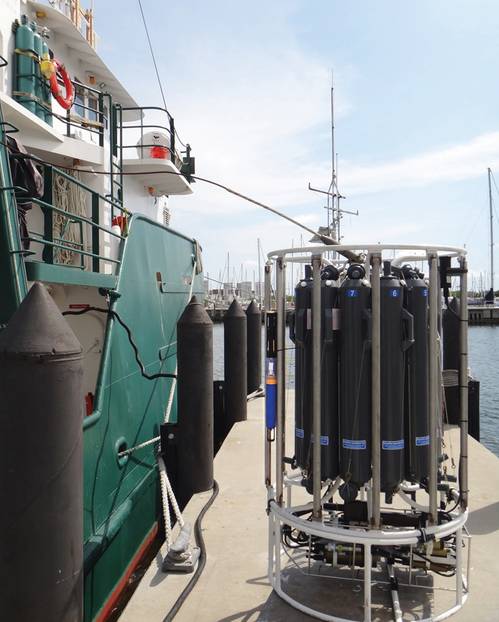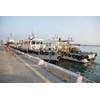Next Generation of CTDs Smaller, Smarter and Tougher
CTDs are the core sensors for oceanographic measurements, providing information on water quality, water density, and speed of sound. Many CTDs are designed to operate in specific applications such as vertical profiling or long-term monitoring and include capabilities such as data logging, high-speed sampling, antifouling systems and additional sensor inputs. Although such systems can offer broad capability and good sensing performance, they are often large, expensive, and challenging to set up, maintain, and transport.
YSI Inc. (a Xylem brand) has introduced the EXO monitoring platform, designed specifically for challenging marine applications, to meet the need for a smaller, low power and more flexible CTD.
“EXO offers a major leap forward in the size, power draw, flexibility and maintenance of a small but powerful CTD. More than 20 YSI engineers have worked on this platform for over three years to create something truly exciting for the marine sensing community,” says Rob Ellison, Executive Director of R&D, YSI.
The EXO platform has a smart sensing system that allows users to quickly configure a system with the sensors of interest for a particular application. On-board power, data logging, and non-toxic antifouling simplify set up and system size. System maintenance is streamlined through smart sensors and universal sensor ports, allowing users to carry only calibrated sensors (5/8-in. diameter, 5-in. length), to the field rather than the entire monitoring system. The small sensors can be removed from the system and recalibrated; they store their calibration and metadata inside and reconnect to the system seamlessly. The stored metadata also allows centralized calibration of sensors and easy field-swapping as well as affordable redundancy.
High-Accuracy Sensors
Building an EXO system with the desired sensors - such as fDOM, chlorophyll fluorescence, cyanobacteria fluorescence, turbidity, optical dissolved oxygen, pH, and ORP - is as easy as plugging the sensor into one of the smart ports via the Impulse wet mate connectors. An auxiliary port is also available for easy integration of a third-party sensor or for daisy-chaining multiple EXO sondes.
“One of the biggest headaches is integration,” says Ellison. “So, an exciting feature of the EXO platform is its smart ports, which automatically recognize the sensors plugged into them and communicate this data to the data logger or DCP, thus streamlining what was once a complex set-up process.”
The EXO2 platform, designed for long-term monitoring, offers six sensor ports in addition to the CTD as well as a central port of the antifouling wiper and an auxiliary port. The EXO1 platform is designed for shorter term monitoring, profiling and sampling applications with three sensor ports in addition to the CTD. Either platform can be configured quickly in the field for a broad variety of applications.
Rugged Materials for Extreme Environments
The materials used in EXO provide unprecedented reliability in field applications, such as long-term monitoring and vertical profiling to 250-m depth. Titanium sensors, sapphire sensor windows, and wet-mateable connections result in an instrument that will stand the test of time and reduce the total cost of ownership. Highly durable Xenoy polymer stands up to high pressures underwater without leaking and resists the corrosion of saltwater. Additionally, the materials perform reliably in higher temperatures, up to 80°C.
Xenoy
Many of EXO’s polymer components are molded from Xenoy resin. Xenoy was chosen because of its strength, impact resistance, chemical resistance, and low water absorption. YSI has been using the material for several years on field products with success. Xenoy is more environmentally friendly to mold than PVC and has better epoxy adhesion properties than acetal resin. “We researched other undersea products and found that dive lights used Xenoy successfully. From this, we refined an alloy mix for the polymer to especially suit the EXO instruments,” says Ron Metzger, Lead Mechanical Engineer on the YSI development team for EXO. The mix includes adding another alloy to the polymer for UV resistance and degradation.
Metzger continues, “Xenoy’s molding properties allowed us to fill both thin and thick wall parts to create both an ergonomic shape for easier gripping as well as a unique, patent-pending reinforced interior structure.” The internal honeycomb-like structure of the EXO2 sonde imparts superior strength against external water pressures at depths of up to 250 m. The slimmer EXO1 has an internal stainless steel sleeve overmolded in Xenoy polymer. Xenoy is used as the exterior surface in place of metal in high-pressure underwater applications without being subject to corrosion like most metals.
Titanium
EXO sensors are made from grade 2 titanium, or commercially pure titanium. Titanium is commonly used for deep-sea instrumentation because of its corrosion resistance and strength at deep depths. EXO sensors are laser-welded shut and fully sealed, providing excellent leaking resistance. Metzger notes, “These are great properties but titanium is an expensive material; however, the investment is worth it for the improved quality and durability that oceanographic users require.”
Connectors that Resist Corrosion
EXO’s wet-mate connectors for sensors and cables resist corrosion when wet. Moisture and dampness are ever-present when deploying and swapping instruments in the field. However, robust Impulse connectors (aluminum-bronze alloy plated in gold) provide superior corrosion resistance, even if the user drops the instrument with an exposed four-pin sensor connector directly in the water.
Tight Seals Are Leak-proof
Laser-welded joints on the sensors plus double O-ring seals prevent leaks in all water environments, from shallow to deep. All parts go through rigorous pressure/temperature testing before they leave the factory. Other tough components include exclusively designed Neoprene and urethane rubber shields on the connectors.
Sapphire glass on optical sensor windows is hard and durable and bonds well to metal for a tight seal on the probe face. The material is optically clear for the wavelengths used by EXO sensors and it won’t interfere or fluoresce. The sapphire glass’s smooth surface also resists biofouling and stands up well to regular sweeps from the anti-fouling wiper system.
Anti-fouling Makes a Clean Sweep
Built-in antifouling systems protect the integrity of the water quality data when the equipment is submerged in highly productive waters. A central wiper with a large brush on the EXO2 actively sweeps away fouling organisms from the sensors before the organisms get a foothold. This wiper has low power requirements, an optimal design for continuous monitoring. Where the sensors connect to the instrument body, EXO uses blended copper-brass alloy components to resist biofouling build-up. Copper is a passive anti-fouling agent and does not use harmful chemicals to clear biofouling. On the body of the instrument, Xenoy is well-suited for rigorous cleaning, such as scraping off barnacles, and can be taped or painted with common anti-fouling paint without “crazing,” or cracking over time.
Big Success in a Small Package
The EXO water monitoring platform is small and lightweight. Its low power consumption* positions it well for continuous data collection at challenging and remote marine environments. And its robust materials rate the system to a depth of 250 meters - suitable for many coastal and estuarine applications.
The new platform has been well accepted; YSI booked more than $2m in orders for the EXO instruments in the first three months following its release.
“We’re excited to bring this new, advanced platform to the water monitoring community,” said Tim Finegan, Director of Environmental Monitoring, YSI. “We began the development of EXO by listening to user feedback and now we’re able to deliver a solution that meets a variety of water monitoring needs - including deeper depths; more rugged materials to extend deployment times; and streamlined calibration procedures to save users time.”
*Typical EXO2 power draw (CTD, DO, Turbidity, pH, Chlorophyll, Cyanobacteria, fDOM) at 12V: ON = 109 mA; SLEEP = 0.17 mA. System is on for ~10 seconds per sampling period.
About the Author
Danielle Dumont is the Marketing Communications Manager for YSI’s environmental monitoring products. She has been with the company for 11 years.
(As published in the November/December 2012 edition of Marine Technology Reporter - www.marinetechnologiesnews.com)














 December 2025
December 2025



